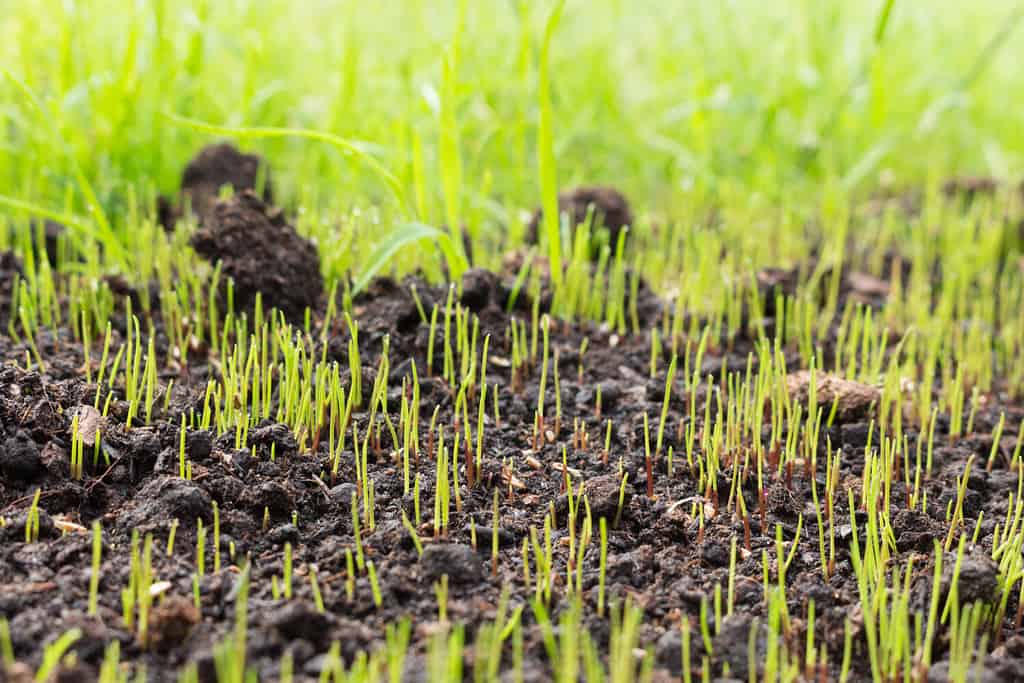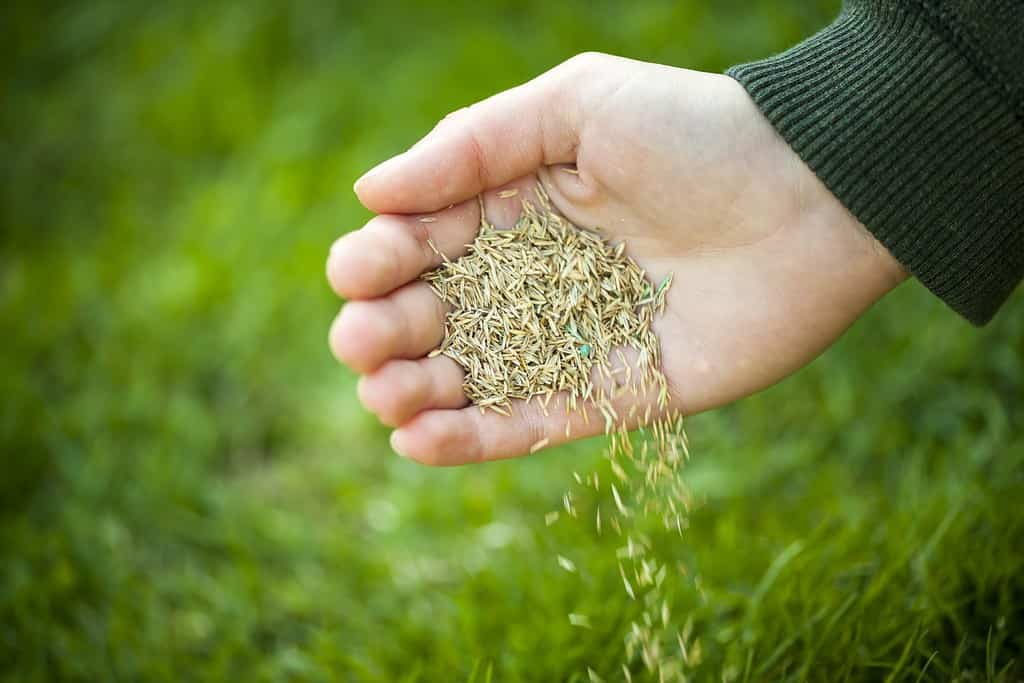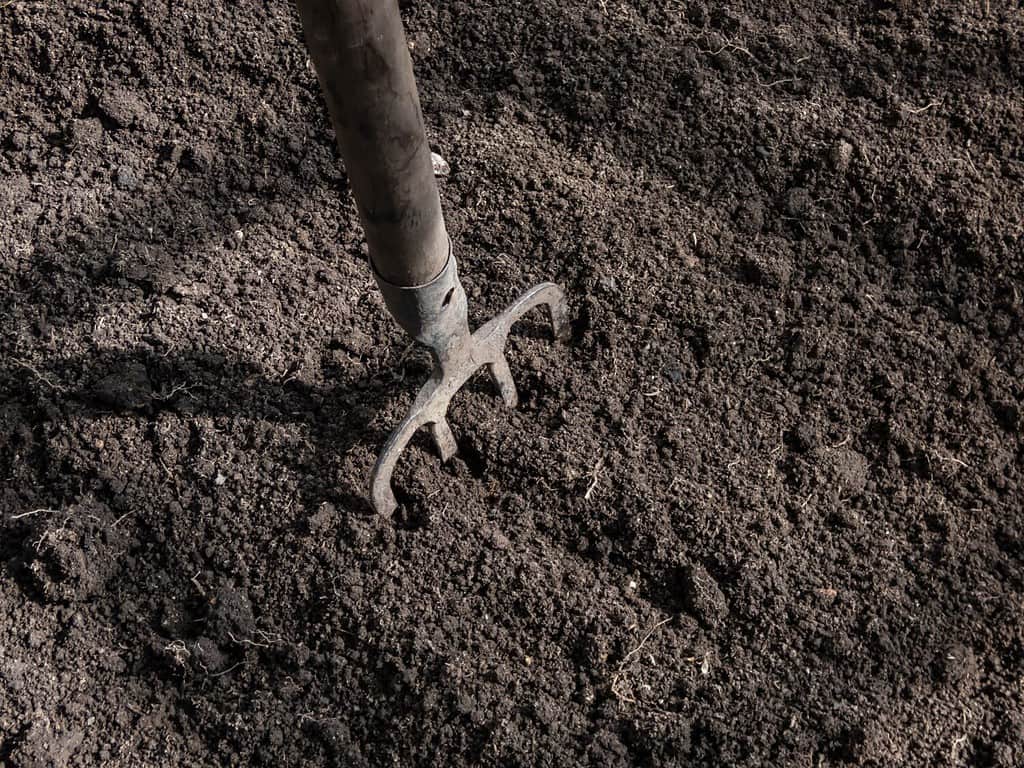Lawn care is something many people take pride in. Having the greenest grass and the best-kept yard is often the goal for many homeowners. Part of having the best yard means having the best grass. Sometimes, your home doesn’t come with the best grass, and you need to plant your own. However, what if you purchase your home in the winter? Can you plant grass seed in the winter, or do you need to wait until the warmer months to start planting? This article will answer that question and tell you the five critical things you need to know about grass seed in winter.
5 Critical Things to Know About Grass Seed in Winter
Here are the top five things you should know before you plant your grass seed in the winter.
1. What to Call the Process

The process of planting your grass seed in the winter is most often referred to as dormant seeding.
©philmillster/Shutterstock.com
The term for planting grass seed in the winter is known as dormant seeding. Some also refer to it as winter or snow seeding. Dormant seeding involves you planting the grass seeds at a very particular time during the winter. You must plant them while the ground is not frozen but while it is cold enough that they will not germinate until the following spring as the soil warms.
2. The Best Time to Plant

According to studies, February has the highest success rate of seed growth with dormant seeding.
© Cristian Bortes from Cluj-Napoca, Romania / CC BY-SA 2.0 – Original / License
While you can do dormant seeding in any of the winter months, there has been evidence that certain months produce better results in grass growth. According to Kansas State University, there was a study in which researchers looked at the growth of seedlings that were planted from December through March. When the researchers checked the growth rate in April, it showed “February planting to have the highest cover of grass at 73 percent.” Based on this research, it appears that your best chance at successful growth for dormant seeding is to plant in February. Experts believe that planting too early leaves too many variables. Those occasional warmer winter days could confuse the seedlings and cause them to sprout. Then, they would not survive the harsh winter weather that follows. This would inhibit them from growing and surviving until the spring.
3. Picking the Right Seeds

One thing to know about grass seed in the winter is which seed will do best. Lawn experts highly recommend Black beauty grass seeds.
©Elena Elisseeva/Shutterstock.com
While dormant seeding has a similar process to seeding at any other point in the year, there are still several factors to keep in mind. One of those factors is ensuring that you select the right seeds. You want to ensure you select a seed that will withstand the harshness of the winter months and produce grass in the spring. According to Jonathan Green Lawn Care, Black Beauty grass seeds are preferred among people. These seeds have been specially developed to be resistant to disease and drought. They also have much deeper roots than other brands of seeds, which can help with their growth rate. According to data, sod growers across the United States favor this seed.
4. Preparing Your Soil

When dormant seeding, you should test, amend, and rake your soil to prepare for your seeds.
©Kristine Rad/Shutterstock.com
Testing and Amending Your Soil
Although it may seem like there is not much to do in the winter, you still need to prepare your soil for your seedlings properly. Some people like to test their soil prior to planting. A soil test can tell you if there are any deficiencies in nutrients before you begin. You can modify your soil with the minerals, compost, fertilizer, or other amenities it may need to bring it to your desired levels.
Raking Your Soil
Before you begin raking your soil, you should cut your current grass. Be sure to cut it slightly lower than usual. It should be down to about 2 inches high. Once your soil and grass are at the desired levels, you can begin to prepare for the seedlings. You must plant your seedlings in loose soil for them to succeed. To loosen the soil, you can rake the area. Raking not only helps clear debris from the top of the soil but can help to loosen the soil to allow the seedlings access to it more easily. You can use a handheld rake for smaller areas and a power rake for larger areas. Additionally, a slit seeder could be used to assist in this process. The slit seeder creates shallow holes in the soil for your seed to be dropped into and lightly packs them in.
5. Watering Your Soil

While watering is important for your seeds, be sure not to overwater them. Soggy soil is not good for seeds.
©iStock.com/
After preparing your soil, you want to ensure you provide your seeds with water. Experts recommend thoroughly watering the area between 0.5 to 0.10 inches. The winter months have cooler temperatures and shorter days, which help keep the moisture in the soil for your seedlings. Additionally, when snow melts, that can provide additional moisture for your seeds. Although water is important, another thing to know about dormant seeding is not to let your soil become too moist or soggy. That could damage the success rate of your seeds.
Summary of the 5 Critical Things to Know About Grass Seed in Winter
The table below recaps the top five critical things to know about grass seed in the winter. Remember, when dormant seeding, your success rate depends upon all of these things and some things that are out of your control. Weather will affect your seedlings. For example, in most cases, seeds are better protected and perform better in years with heavy snowfall. While good preparation helps, be aware that depending on additional factors, overseeding in the spring may still be necessary.
| Rank | Step | Description |
|---|---|---|
| 1 | What to Call the Process | This process is most often referred to as dormant seeding. It can also be called winter or snow seeding. |
| 2 | The Best Time to Plant | Studies suggest that February is the best month for dormant seeding. |
| 3 | Picking the Right Seeds | Black Beauty grass seeds come highly recommended. |
| 4 | Preparing Your Soil | Test, rake, and loosen your soil to prepare it for your seeds. |
| 5 | Watering Your Soil | Water your soil between 0.5 and 0.10 inches of water. |
The photo featured at the top of this post is © iStock.com/
Thank you for reading! Have some feedback for us? Contact the AZ Animals editorial team.







